The People's League for the Defence of Freedom
The People's League for the Defence of Freedom
The 1958 London bus strike saw the complete withdrawal of all Central and Country areas buses from 5th May to 20th June. Initially, no alternative bus transport whatsoever was available, and travellers had to rely on lifts from public spirited motorists. As the first few weeks passed, however, and it became evident that the strike had set in for some time to come, a right wing organisation calling itself "The People's League for the Defence of Freedom" obtained permission to run a few bus services in and around the capital. I believe that, at first, no fares were charged, but soon authority was given to charge a flat fare of 6d in old money - 2½ pence in today's decimal currency. PLDF route 2 ran between Croydon and New Addington, the latter place being a very large estate close to the Kent border, some six miles from central Croydon.
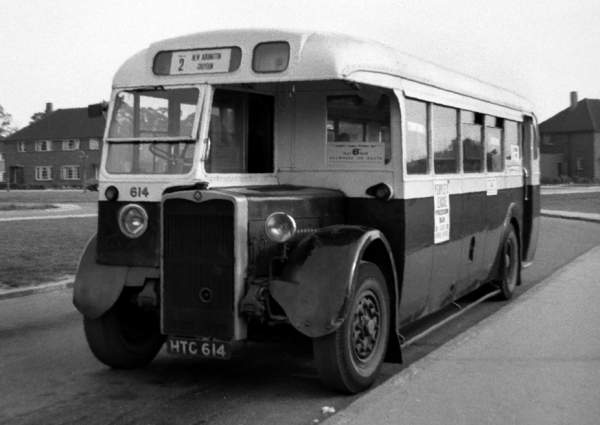
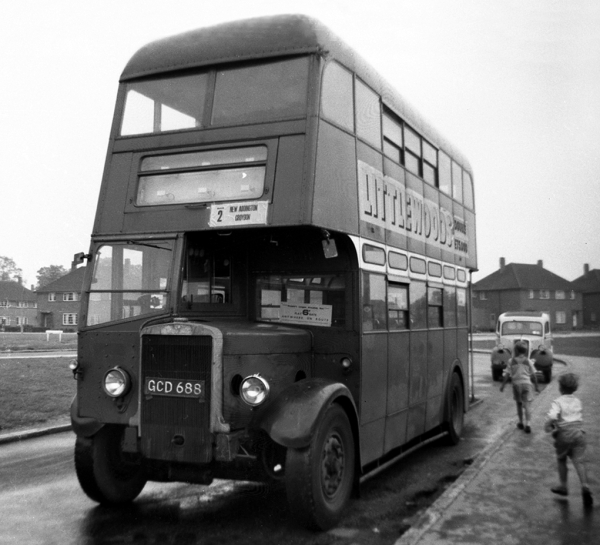
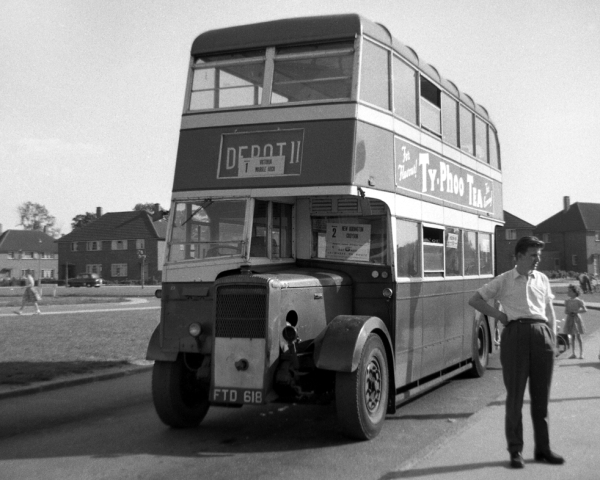
Roger Cox
07/2011
14/07/11
I forgot to state that the pictures were all taken at the Homestead Way terminus at New Addington. I am just speculating, but the body on the TD7 might have been a Bristol BBW or early ECW body. The row of small windows above the lower deck windows has an ECW look about it. One wonders also what happened to the original Park Royal body. Hopefully, with the wealth of knowledge held by the contributers to this website someone will come up with the answer.
Roger Cox
14/07/11
I seem to recall that the same organisation ran an ex Leicester AEC Renown on free services somewhere in the Capital during the same very serious strike.
Chris Youhill
14/07/11
The TD7 was one of a batch ordered by Southdown and diverted to Crosville. The body is apparently one designed and built by Crosville themselves.
David Beilby
15/07/11 - 07:36
Southdown had ordered 27 Leyland TD7, with Park Royal bodies, 23 highbridge, 4 lowbridge. They were all delivered elsewhere, and GCD688's appearance in Croydon may have been it's nearest approach to Brighton (just turn on to the A23 and keep going...) Seven highbridge went to Western Welsh, and 16 to Crosville. These all kept the Brighton GCD series registrations reserved for them. The four lowbridge ones went to Cumberland who registered them locally. The Brighton registrations thus released were used by Southdowns on some Guy Arab utilities later. All the Western Welsh ones had their Park Royal bodies rebuilt by Longwell Green(5)or Welsh Metal Industries(2) in 1950, and were all withdrawn in 1956. All the Cumberland ones were rebodied with new Burlingham lowbridge bodies in 1950, and lasted until 1959. Eleven of the Crosville ones (including GCD688 shown) were rebodied by Crosville themselves in 1952/53 (some are noted as "Pearson/Crosville"). The unrebodied ones were withdrawn in 1956/57, and the rebodied ones in 1957-59, so they didn't last much longer! The list I'm using for all this info doesn't give any subsequent histories for these vehicles. The info comes from a Southdown Enthusiast Club fleet history. I hope it's of interest. It's also true that that an AEC Renown 3-axle d/d was used by the PDLF during the London strike. I wonder if it brought back memories of the LT class for the public, or LT staff! It was a former Leicester Corporation model, new c. 1939. The body was NCME or Metro-Cammell (Leicester split the body contract for the batch), and I think that if Met-Cam was the builder, they had been instructed to build it to the NCME design, with the wide front and rear pillars and well-curved profile.
Michael Hampton
16/07/11
Further to Michael Hamptons comments, GCD 688 was new in May 1941 as Crosville M126 and was rebodied by Crosville on Pearson frames. Exactly how much of the design was of Crosville origin, I wouldn't like to say. As stated the rebodies didn't last very long compared with, say ECW rebodies, and people have commented that it wasn't really worthwhile. Perhaps somebody could give us more info about Pearson as my knowledge of them is pretty well zero.
Nigel Turner
17/07/11
I, too, had never heard of Pearson coachbuilders, but, ferreting about on the internet I came across this page. This appears to be the company mentioned by Nigel, to whom our thanks are due for pointing us in the right direction.
Roger Cox
17/07/11
Under the Pre-War heading of Pearson's website is a photo of some coaches (one normal control), all the same make. They might be Guys, maybe even Leylands, but I'm unsure. Anyone more certain of the make/model?
Chris Hebbron
18/07/11
In 1950 Liverpool Corporation received 100 AEC Regent IIIs (JKF 900-999). The bodies all had Weymann frames, of which some were finished by the Corporation and the rest farmed out to local concerns, including 9 to Pearsons.
Peter Williamson
18/07/11
Did that make them Weysons or Pearmanns?
David Oldfield
10/12/11 - 07:30
The book "London Bus File 1955-62" by Ken Glazier has a few pages on this operator using data derived from the PSV Circle. Sadly, some of the details are wrong. The two Crossleys are given as being ex Leicester Corporation instead of Lancaster, and the Ex Crosville TD7s are shown as having Park Royal bodies. Thanks to research by the contributors above, we now know that this bodywork was by Crosville on Pearson frames.
Roger Cox
16/12/11 - 08:23
This vehicle was one of a small batch of three which entered service with Lancaster City Transport in June 1947 and which therefore, as stated, had a relatively short life with LCT. Even in the late 1950s the company accountant would be starting to frown on a 36 seat bus with a crew of two and LCT introduced its first o-m-o routes in 1957, for which these buses were obviously of no use and were therefore advertised for sale, along with four Daimler COG5, 2 Daimler CVG5 and two Leyland Tiger PS1 buses, all rear entrance single deckers. One single deck CVG5 (the well-known NTF 466) was converted to front entrance, which, together with the o-m-o conversion of the two ex Morecambe Regals, the acquisition of four Regal IVs from Rochdale and the subsequent arrival of five new Tiger Cubs in 1958/9 allowed one-manning to expand.
Lancaster acquired four double deck Crossleys some four months after HTC 614 and a further five the following year. These nine buses had an average service life of 18 years, with the longest serving, JTD 961, just failing by a month to reach its 21st birthday. Lancaster certainly had good value from its Crossleys!
Dave Towers
09/07/16 - 17:02

In respect of the article on your site about the People's League 6d bus service run during the 1958 London strike, I thought you might be interested in the attached photograph, which shows another double decker not mentioned in your feature. At a guess I would say it is parked near Kennington (the fencing is very LCC) pending running on Route 1 from the Oval to Thornton Heath
Research indicates that it is an ex-Crosville vehicle; a 1938 TD5, which was originally fitted with an ECW L26/26R body. Although the projecting blind box is distinctive, I cannot locate anything similar, except on a Massey bodied TD4, late of Portsmouth.
If any of your readers can shed any light on the body particulars, I shall be extremely grateful. Should you be interested, I also have an offside photo of the TD7 parked in the same location, although snickered for Route 1.
Graham Whyte
11/07/16 - 07:19
Film of this operation appears on the Video 'Omnibus UK Archive'. My copy wore out years ago but possibly a DVD is now available.
In 1967 or 1968 I heard Edward Martell ( One of the former leading lights in the People's League) mention that the service was used by, among others, London Transport workers travelling to the picket line!
The last comment by Graham Whyte re the Leyland TD5 mentions the projecting blind boxes on Portsmouth TD4's. However, these had Leyland rather than Massey bodies.
Andy Hemming
12/07/16 - 07:34
There is a short 'Movietone News' clip with some interesting buses at this link: BUS RIDES - FREE!
Chris Hebbron
12/07/16 - 18:09
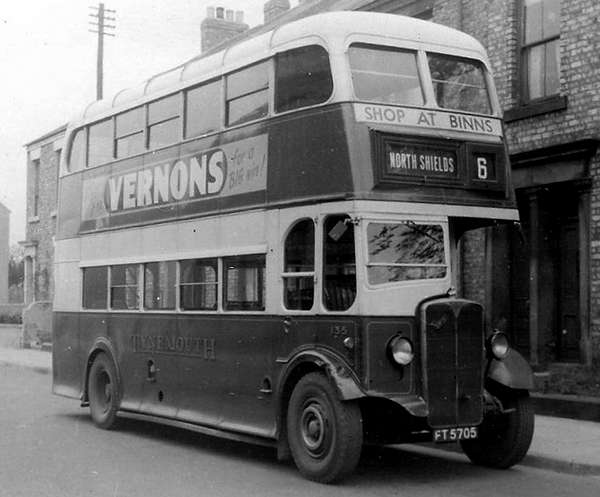
One of the buses featured on the film is FT 5702. It was one of 15 Weymann bodied AEC Regents delivered to Tynemouth & District in 1946; they were FT 5698/5712 128/142, 141/2 carried the Wakefields name, 135 was from the same batch, and is shown here in its original livery. The one on the film was in the later all red with cream roof and centre band. 135 seems to have suffered some damage to the front wing, and must be due for an overhaul and repaint, otherwise it would never have been allowed out in that state
Ronnie Hoye
14/08/16 - 06:15
I have just found your interesting article about the buses that were used as 'strike breakers' in London in June 1958. I have also found the video 'Free Bus Rides' on YouTube.
I notice early on in the clip that FT 5702 can clearly be seen with the later dark livery. However, a few seconds later, a similar bus with the earlier livery can be seen. You can't make out the registration but you can see that the rear of the bus has "Shop at Binns". Is it possible that the People's League obtained more than one ex-Tynemouth bus?
David Armstrong
04/12/21 - 06:17
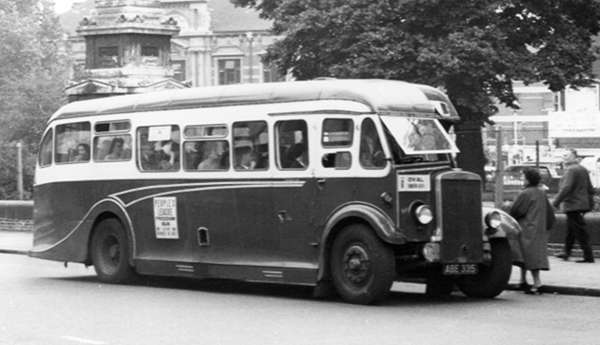
ABE 335 was new to Lincolnshire Road Car Co Ltd (LRCC) in 1938, originally numbered LT528.
It is a Leyland Tiger TS8, with Harrington C32F bodywork (body number 16117), the body being overhauled by ECW, Irthlingborough in October 1944.
It was renumbered 1470 in October 1953, and withdrawn in October 1957.
Sold to AE Connorton Motors (dealer), London SW9 in November 1957.
To R & RVS Taylor, London SE1 in December 1957, withdrawn in December 1959.
Used by the People's League for the Defence of Freedom, London SW18 from June 1958 until January 1959.
Scrapped December 1959.
All this information has been taken from PE18, A Fleet History of Lincolnshire Road Car Company, Part 1 (1928-1949), published by the PSV Circle.
Brian Cash
Comments regarding the above are more than welcome please get in touch via the 'Contact Page' or by email at obp-admin@nwframpton.com
If you have any bus related photographs that you would like to appear in a gallery on this website please send them to me by email at obp-admin@nwframpton.com
All rights to the design and layout of this website are reserved
Old Bus Photos from Saturday 25th April 2009 to Wednesday 3rd January 2024